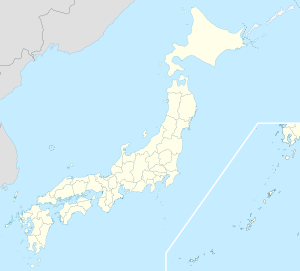Futami-ga-ura
Futami-ga-ura is a sub-bay or inlet of Ise Bay in Japan, where the Isuzu River enters the bay.[1]
Futami-ga-ura | |
|---|---|
 | |
 | |
| Coordinates: 34°30′33″N 136°47′27″E / 34.50929°N 136.7909°E | |
| Country | Japan |
| Prefecture | Mie Prefecture |
| Time zone | Japan Standard Time |
| Geocode | http://sws.geonames.org/1863740 |
[2] It is located in Mie prefecture, in the southern part of the country, 300 km southwest of Tokyo.
It is where the famous Meoto Iwa rocks are found[3]
Description
[edit]Futami-ga-ura is a delta formed at the mouth of the Isuzu River that flows into Ise Bay. It is part of Ise-Shima National Park that has been designated a national scenic spot, and has been selected as one of Japan's 100 best beaches. It has sometimes served as a site for ritual purification (misogi) prior to worshiping at Ise Jingu.[4]
A rock formation called Meoto Iwa, which is within the precincts of Futami Okitama Shrine in Tateishizaki, is a well-known geological feature with significance to Shinto devotees.[3][tone]
Climate
[edit]The climate is temperate. The average temperature is 14 °C. The warmest month is July, at 23 °C, and the coldest January, at 5 °C.[5] The average rainfall is 2,387 millimeters per year. The wettest month is June, with 316 millimeters of rain, and the wettest January, with 60 millimeters.[6]
| ||||||||||||||||||||||||||||||||||||||||||||||||||||||||||||||||||||||||||||||||||||||||||||||||||||||||||||||||
Town
[edit]Futami (二見町, Futami-chō) was a town in Watarai District, Mie Prefecture, Japan. As of 2003, the town had an estimated population of 9,008 and a density of 754.44 persons per km². The total area was 11.94 km². On November 1, 2005, Futami, along with the town of Obata, and the village of Misono (all from Watarai District), were merged into the expanded city of Ise and thus no longer exists as an independent municipality.
The Meoto Iwa are two "wedded rocks", in the sea by the town. Futami is mentioned by Matsuo Bashō in his haiku hamaguri no / futami ni wakare / yuku aki zo. Literally, Hamaguri clams of Futami break apart in Autumn. Poetically,
As firmly cemented clam shells
Fall apart in Autumn
So too, I take to the road again [7]
Futaminoura Beach
[edit]Futami beach was opened in 1881 ( Meiji 15) by the first Surgeon general, Matsumoto Ryōjun, and was designated by the Director of the Ministry of Home Affairs, Sanitation Bureau, Nagayo in 1882 (Meiji 16), the first officially recognized beach in Japan. It is said that Emperor Taisho also trained in swimming when he was a child. At that time, the sea bathing was for medical purposes (bath digging), and there were cold baths that went into the sea and hot baths that were soaked in seawater warmed by a bathtub on the beach. Including, the inn town that sings Shioyuji was formed[4]
Guest house
[edit]There is a guest house Hinjitsukan located in the area. It was designated a tangible cultural property designated by Mie Prefecture on March 17, 2004. It was designated a national important cultural property on June 29, 2010 .[8][verification needed]
External links
[edit]- Official website of Ise (in Japanese)
Sources
[edit]- ^ "Japan Atlas: Futamiura in Ise". web-japan.org. Retrieved 2023-03-09.
- ^ Futami-ura sa Geonames.org (cc-by); post updated 2013-10-07; database download sa 2017-02-07
- ^ a b "Futami Okitama Jinja(Wedded Rocks)". Organización de Convenciones de Turismo de Ise Shima. Retrieved 28 September 2021.
- ^ a b Archived copy Archived 2014-11-21 at the Wayback Machine
- ^ "NASA Earth Observations Data Set Index". NASA. Archived from the original on 6 August 2013. Retrieved 30 January 2016.
- ^ "NASA Earth Observations: Rainfall (1 month - TRMM)". NASA/Tropical Rainfall Monitoring Mission. Archived from the original on 29 June 2019. Retrieved 30 January 2016.
- ^ "Closure, the final haiku". 26 September 2019.
- ^ "About に何も見つかりません". hinjitsukan.com. Archived from the original on 14 July 2019. Retrieved 30 June 2022.

